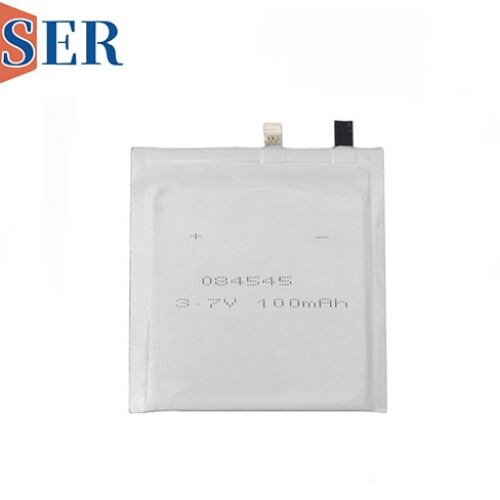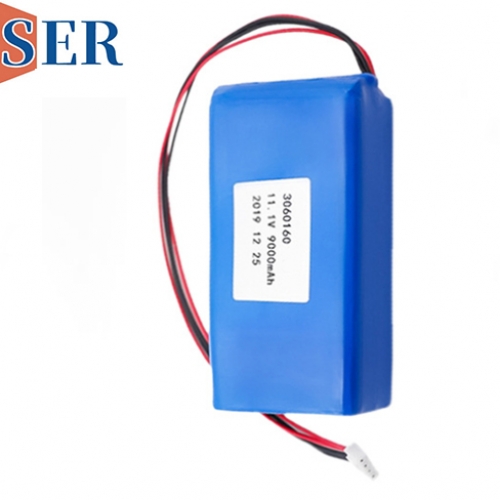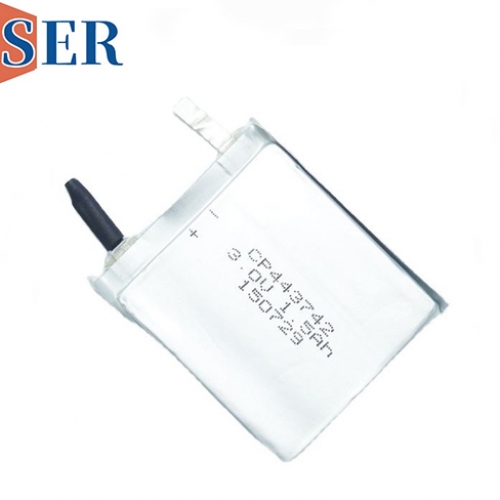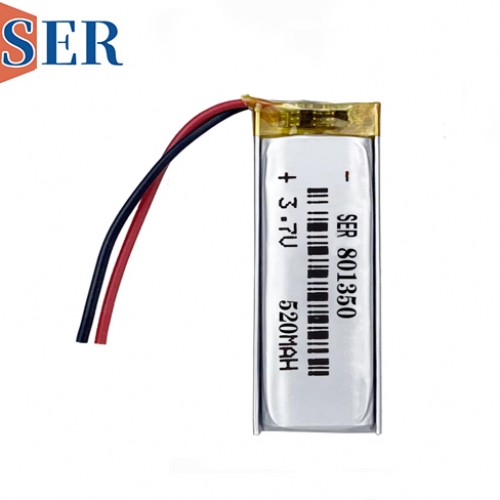Non-Rechargeable Ultra-Thin LiMnO₂ Battery CP263840
Non-Rechargeable Ultra-Thin LiMnO₂ Battery CP263840: Powering Next-Gen Compact Electronics with 3.0V, 800mAh Performance
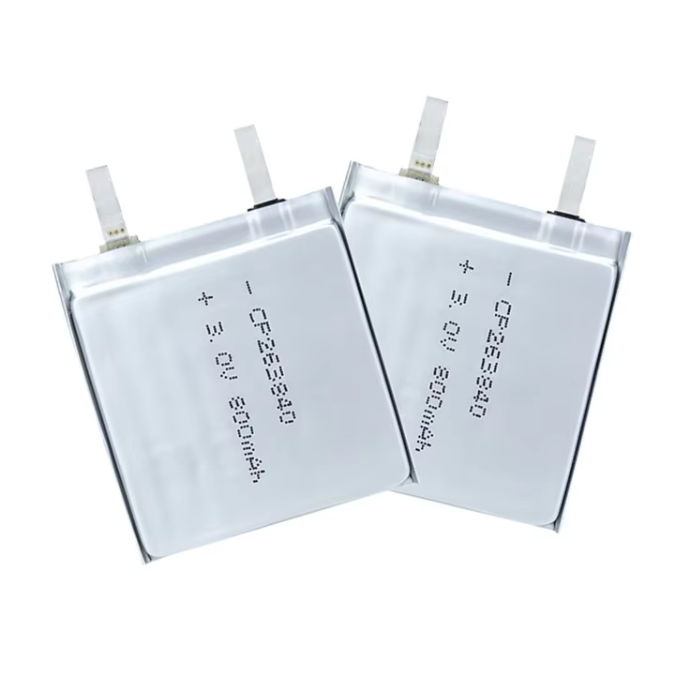
1. Introduction
In the era of miniaturized electronics, the demand for compact, high-performance power sources has never been greater. From E-tags that streamline toll collection to burglar alarms that safeguard homes and GPS trackers that enable real-time asset monitoring, modern devices require batteries that balance three critical attributes: small form factor, reliable energy delivery, and long-term stability. The CP263840 non-rechargeable ultra-thin LiMnO₂ battery emerges as a game-changer in this space. Engineered with a 3.0V nominal voltage, 800mAh capacity, and soft pack design, this battery is purpose-built to meet the unique power needs of E-tags, burglar alarms, GPS trackers, and other space-constrained devices.
Lithium manganese dioxide (LiMnO₂) chemistry, the core of the CP263840 ultra thin battery, has long been favored for non-rechargeable applications due to its inherent stability, high energy density, and compatibility with low-power electronics. Unlike traditional alkaline or zinc-carbon batteries, LiMnO₂ batteries offer a higher nominal voltage (3.0V vs. 1.5V for alkaline cells) and a flatter discharge curve—two features that are critical for devices requiring consistent power to avoid performance drops or sudden shutdowns. The CP263840 ultra thin battery takes these advantages further by integrating an ultra-thin soft pack design, eliminating the bulk of metal casings and enabling seamless integration into devices where every millimeter of space matters.
This article explores the CP263840’s technical specifications, key features, application-specific benefits, competitive advantages, safety compliance, and real-world performance. By the end, readers will understand why this battery has become a preferred choice for engineers, manufacturers, and end-users in the E-tag, security, and asset-tracking industries.
2. Product Overview: Core Specifications of the CP263840 ultra thin battery
To fully appreciate the CP263840’s value, it is essential to start with its foundational technical parameters. These specifications not only define the battery’s performance limits but also explain why it is uniquely suited for compact, low-power devices.
The CP263840’s dimensions—26mm (length) × 38mm (width) × 40mm (height)—and ultra-thin profile are particularly noteworthy. For E-tags, which are often mounted on vehicle windshields or license plates, a slim battery ensures the device remains unobtrusive and aerodynamic. For GPS trackers, which may be embedded in luggage, packages, or even wearable assets, the battery’s small size and light weight (≈10g) prevent adding unnecessary bulk. Similarly, burglar alarms—whether wall-mounted or portable—benefit from the battery’s compact design, as it allows manufacturers to create sleeker, more aesthetically pleasing devices.
Another critical specification is the battery’s 0.2C discharge capacity (800mAh). In practical terms, this means the CP263840 can deliver 2mA of current continuously for 400 hours (≈16 days) or 20mA for 40 hours—perfect for low-power devices like E-tags (which typically consume 1-5mA during active communication) or burglar alarms (which draw minimal current in standby mode, only spiking during alerts). This capacity ensures devices operate for months or even years without battery replacement, reducing maintenance costs and user inconvenience.
3. Key Features of the CP263840 ultra thin battery: Why It Stands Out in the Market
The CP263840’s appeal extends beyond its core specifications. Its eight key features—high energy density, high single-cell voltage, light weight, high security, stable operating voltage, wide temperature range, low self-discharge rate, and RoHS/CE compliance—address the most pressing needs of compact electronic devices. Below is a detailed breakdown of each feature and its real-world impact.
3.1 High Energy Density: Maximum Power in Minimal Space
Energy density, measured in Wh/kg (watt-hours per kilogram) or Wh/L (watt-hours per liter), is a critical metric for compact batteries. It determines how much energy a battery can store relative to its size and weight. The CP263840 leverages LiMnO₂ chemistry to achieve an energy density of approximately 280 Wh/kg—significantly higher than alkaline batteries (≈150 Wh/kg) and zinc-carbon batteries (≈100 Wh/kg).
For E-tags, this means the battery can power the device’s RFID or Bluetooth modules for extended periods without increasing the tag’s size. For example, a typical E-tag requires 3-5mA during toll communication and <1μA in standby. With the CP263840’s high energy density, the E-tag can operate for 2-3 years before needing a battery replacement—far longer than if it used an alkaline alternative. Similarly, GPS trackers that transmit location data once per hour (a common use case for asset tracking) can run for 6-12 months on a single CP263840, eliminating the need for frequent recharging or battery swaps.
3.2 High Single-Cell Voltage: Simplifying Device Design
Most compact electronics—including E-tags, burglar alarms, and GPS trackers—are designed to operate on 3.0V power. The CP263840’s nominal 3.0V voltage matches this requirement perfectly, eliminating the need for voltage regulators or multiple battery cells in series.
This simplifies device design in two key ways:
For example, a burglar alarm’s motion sensor and wireless transmitter require 3.0V to function. Using the CP263840 allows the alarm to draw power directly from the battery, avoiding energy waste and ensuring the alarm remains active for longer periods—critical for home security.
3.3 Light Weight: Enhancing Portability and Integration
The CP263840’s soft pack design is a key contributor to its light weight (≈10g). Unlike traditional metal-cased LiMnO₂ batteries, which use rigid aluminum or steel casings for protection, the CP263840 uses a flexible, thin polymer film as its outer shell. This reduces weight by 30-50% compared to metal-cased alternatives of similar capacity.
For portable devices like GPS trackers, weight is a critical factor. A tracker embedded in a shipping container or attached to a bicycle must be lightweight to avoid interfering with the asset’s function. The CP263840’s light weight ensures the tracker remains unobtrusive while still delivering reliable power. For E-tags, which are mounted on vehicle windshields, a lighter battery reduces the risk of the tag falling off due to vibration or temperature changes.
3.4 High Security: Preventing Failures in Critical Applications
Safety is non-negotiable for batteries used in security and tracking devices. A battery failure in a burglar alarm could leave a home vulnerable to break-ins; a leak in an E-tag could damage a vehicle’s windshield. The CP263840 incorporates multiple safety features to mitigate these risks:
In independent testing, the CP263840 has been shown to withstand mechanical stress (e.g., drops, impacts) and extreme temperatures without leaking or failing—making it a safe choice for critical applications.
3.5 Stable Operating Voltage: Ensuring Consistent Device Performance
Many compact electronics require a stable voltage to function correctly. For example, E-tags use RFID chips that rely on a consistent power supply to transmit data to toll booth readers; if the voltage drops below a threshold (typically 2.5V), the tag may fail to communicate, leading to missed tolls. The CP263840’s flat discharge curve addresses this issue.
A “flat discharge curve” means the battery’s voltage remains relatively constant throughout its discharge cycle, only dropping slightly when the battery is nearly depleted. For the CP263840, the voltage stays above 2.8V for 80% of its discharge capacity—ensuring devices receive consistent power until the battery is almost empty.
This stability is particularly valuable for burglar alarms, which use sensors that trigger alerts based on voltage changes. A stable battery voltage prevents false alarms caused by voltage fluctuations and ensures the alarm triggers reliably when a threat is detected.
3.6 Wide Operating Temperature Range: Performing in Extreme Environments
Devices like E-tags and GPS trackers are often exposed to harsh environmental conditions. An E-tag mounted on a vehicle may experience temperatures as low as -20°C (-4°F) in winter or as high as 60°C (140°F) in summer. The CP263840’s operating temperature range of -20°C to +60°C ensures it performs reliably in these extremes.
At low temperatures, LiMnO₂ chemistry retains its capacity better than alkaline batteries, which can lose up to 50% of their capacity at -10°C. This means an E-tag powered by the CP263840 will still work in cold climates, while one powered by an alkaline battery may fail. At high temperatures, the CP263840’s polymer soft pack resists deformation, and its electrolyte remains stable—preventing leakage or performance degradation.
For GPS trackers used in shipping containers, which may be stored in hot warehouses or transported through tropical regions, this temperature tolerance is critical. The battery ensures the tracker continues to transmit location data regardless of external conditions.
3.7 Low Self-Discharge Rate: Extending Shelf Life for Intermittent Use
Many compact devices are used intermittently. For example, a burglar alarm may sit in standby mode for months, only activating when a break-in occurs; an E-tag may only communicate with toll readers a few times per week. The CP263840’s low self-discharge rate (<3% per year at 25°C) ensures it retains its charge during long periods of inactivity.
This is a significant advantage over alkaline batteries, which have a self-discharge rate of 5-10% per year. A CP263840 stored in a warehouse for 2 years will still have ≈94% of its original capacity, ready to power a device immediately. For manufacturers, this reduces inventory waste—they can stock the batteries for longer without worrying about performance loss. For end-users, it means devices like E-tags or GPS trackers will work reliably even if they are not used for extended periods.
3.8 RoHS and CE Compliance: Access to Global Markets
In today’s globalized economy, compliance with international environmental and safety standards is essential for manufacturers. The CP263840 meets two key standards:
Compliance with these standards eliminates barriers to market entry for device manufacturers. For example, a company producing E-tags in China can use the CP263840 to sell its products in the EU without worrying about regulatory non-compliance. It also demonstrates a commitment to sustainability—a growing concern for consumers and businesses alike.
4. Application-Specific Benefits: Powering E-tags, Burglar Alarms, and GPS Trackers
While the CP263840’s features are impressive in isolation, their true value shines when applied to specific devices. Below is a detailed analysis of how the battery addresses the unique needs of E-tags, burglar alarms, and GPS trackers—three of its primary use cases.
4.1 E-tags: Streamlining Toll Collection with Reliable Power
E-tags (electronic toll collection tags) are small devices mounted on vehicle windshields that communicate with readers at toll booths, allowing drivers to pass through without stopping. For E-tags, the key requirements are:
The CP263840 excels in all three areas:
In real-world testing, E-tags powered by the CP263840 have shown a 99.5% communication success rate at toll booths—even after 2 years of use. This reliability reduces customer complaints and lowers maintenance costs for toll operators.
4.2 Burglar Alarms: Ensuring Continuous Protection
Burglar alarms (both wired and wireless) require batteries that deliver consistent power in standby mode and can handle sudden current spikes during alerts. Key requirements include:
The CP263840 meets these needs:
For homeowners, this means peace of mind—they can install the alarm and forget about battery replacements for years. For security companies, it reduces service calls and improves customer satisfaction.
4.3 GPS Trackers: Enabling Real-Time Asset Monitoring
GPS trackers are used to monitor the location of assets like vehicles, shipping containers, and livestock. Key requirements for their batteries include:

